Effective Strategies to Encourage Your Pet Bird Home
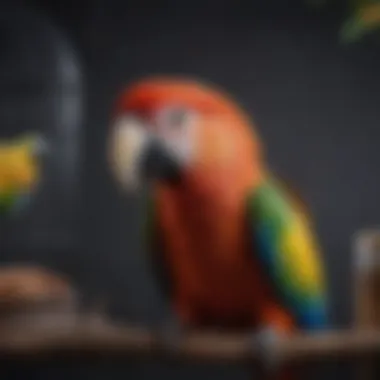
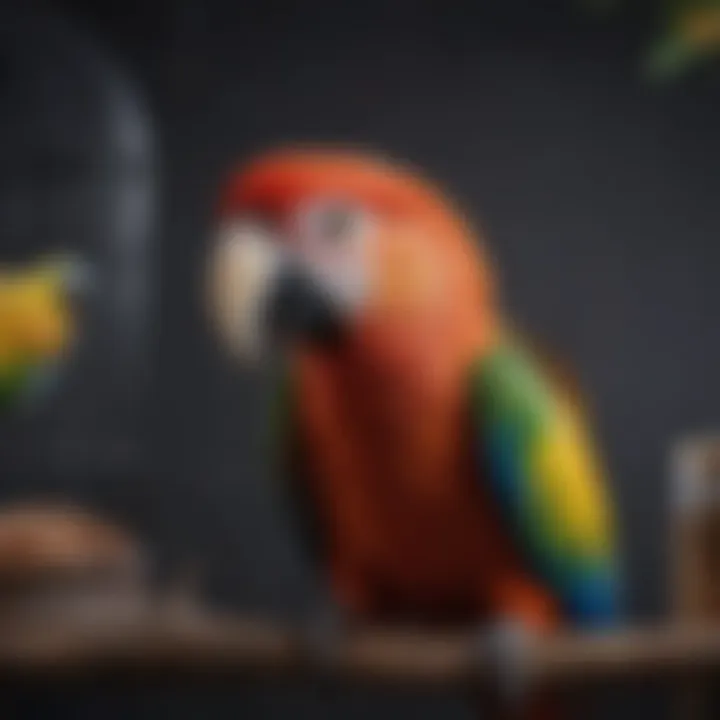
Intro
Having a pet bird comes with unique joys and challenges. One aspect that can often puzzle bird owners is how to get their feathered companion to return to its cage willingly. Unlike many other pets, birds have their own ways of expressing preferences and needs. Thus, understanding their behavior and adopting effective strategies becomes essential for a harmonious living environment. This guide will delve into practical methods to ensure your bird will not only return to its cage but will do so happily.
Care Tips
Taking care of a pet bird requires consistent attention to their daily routines, cage environment, and overall well-being.
Daily Care Routines
Set a schedule: Just like any other pets, birds appreciate routine. Establishing a daily set time for feeding and returning to the cage can create a sense of security for your avian friend.
Offer varied interaction: Engage with your bird through regular out-of-cage time. This develops a routine that encourages your bird to spend quality time with you, leading them back to the cage more naturally when playtime is done.
Cage Setup and Maintenance
An inviting cage increases the chances that your bird will frequently return. Ensure that the cage is spacious enough for movement and equipped with perches at varying heights.
Include toys and accessories: Introduce engaging toys, feeding stations, or even safe natural branches. This helps make the cage a desirable space, in addition to providing mental stimulation.
Hygiene and Cleaning Practices
Maintaining a clean living space is vital for both your pet’s health and emotional well-being.
Regular cleaning: Routine cage cleaning minimizes disease risk. Change bedding, clean toys, and refresh water daily.
Seasonal Care Adjustments
Adjust care routines based on seasons. Ensure adequate warmth during colder months and provide shaded areas during warmer ones since birds may experience stress due to temperature changes.
Behavioral Insights
Understanding a bird's unique body language and behavioral tendencies can equip owners with tools needed to assist in coaxing an avian friend home.
Understanding Bird Body Language
Birds communicate through various signals. Observing these signs — such as puffed feathers during stress or specific vocalizations indicating comfort — can give insights into when coaxing them back to their cage is needed.
Common Behavioral Issues and Solutions
Addressing common issues such as fear or reluctance may include controlled exposure and slowly familiarizing your bird with their cage as a safe haven. Use calm tones and avoid sudden movements.
Positive Reinforcement Techniques
Utilizing treats or praise when they voluntarily return to the cage can reinforce this behavior. This creates a direct association with returning to the cage as being rewarding for your bird.
Social Interaction Needs
Many birds are strongly social creatures. Some birds prefer companionship. Ensure your pet receives sufficient social interaction from you or, depending on your ability, consideration of obtaining another bird may be beneficial.
Nutrition Guides
A well-nourished bird is likely to exhibit more stable and agreeable behaviors.
Essential Diet Components
Establish a balanced diet, addressing key components such as seeds, fruits, vegetables, and high-quality pellets. This can keep your bird energetic and willing to engage.
Safe and Toxic Foods
Being aware of common safe foods compared to those toxic to birds is paramount. Foods like avocado and chocolate should always be kept away from your pet bird's diet.
Supplements and Treats
Consider providing occasional treats and safe supplements. These should not replace primary nutrition but add excitement to your pet’s meals through new tastes and textures.
Wellness and Health
Regular health practices cannot be overstated.
Routine Health Checkups
Scheduling periodical visits to an avian veterinarian can assure any illness is detected early.
Identifying Symptoms of Illness
Remain vigilant for warning signs such as changes in eating habits, feather quality, or patterns in vocalizations.
Preventative Care and Vaccinations

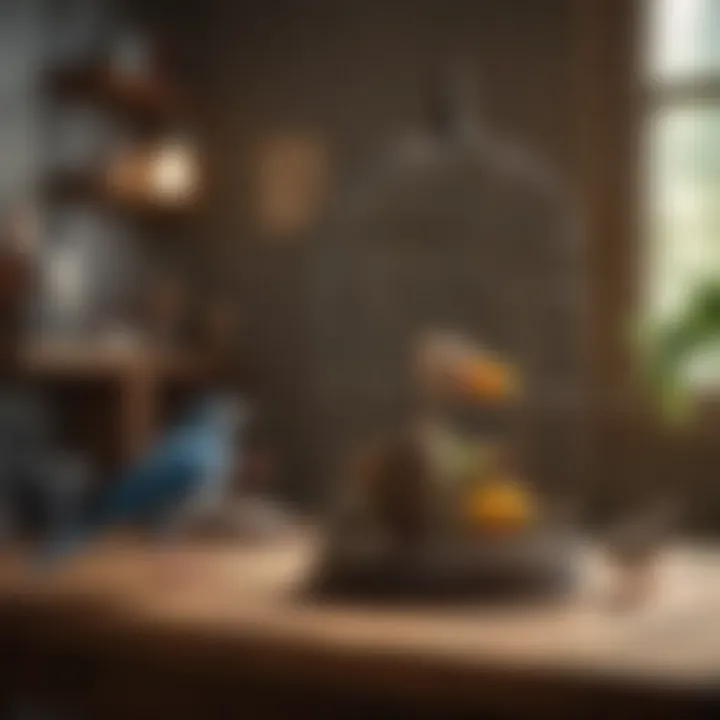
Discuss standard vaccines or preventative care so your pet maintains lower risks throughout life.
Enriching Activities
Mental engagement can often enhance overall well-being and lead to returns to the cage. Keeping your bird occupied reveals a multi-faceted approach to happiness.
Toys and Playtime Ideas
Tailor playtime to suit your bird's species or preferences. Rotate toys every week to keep the environment stimulating.
Training and Tricks
Spend time teaching your bird simple commands or tricks. Positive experience will encourage your pet to return to the cage willingly.
Outdoor Activities and Interaction
If safe and possible within your environment, short outdoor sessions using bird-friendly carriers or flight harnesses offers a change of scenery that can be beneficial.
DIY Projects for Mental Stimulation
Creating safe, stimulating toys or games using common household items can provide endless engagement opportunities for your bird.
The relationship between a bird and its environment is pivotal for achieving harmony in your home. By establishing assurance, ample nutrition and an engaging environment, you make great strides toward enhancing your bond with your feathered companion.
Understanding Avian Behavior
Understanding avian behavior is crucial for pet bird owners. It helps in managing their interactions with these creatures in an effective manner. Birds have distinct ways of communicating their needs and preferences. Knowing these traits equipped the owners with valuable insights for world understanding.
Avian behavior encompasses a range of instincts, emotions, and social structures. Each parrot, budgie, or canary family has unique attributes that dictate its response to various situations. Recognizing these behaviors brings various benefits. First, pets will feel more comfortable in their environment. Second, it minimizes stress, and enhances overall wellbeing.
Basic Instincts of Pet Birds
Pet birds have inherent instincts that drive them. One prime example is their natural tendency to seek safety in high places. In the wild, birds often prefer to perch high to avoid predators. Similarly, understanding this simple need is essential when providing cages and play areas. Secure and elevated perches mimic a bird's instinctual behaviors. Seeing their need addressed promotes comfort in the environment.
Additionally, some birds are enthusiastic vocalizers, which attracts attention or expresses feelings of comfort or unrest. Educating owners about these instincts allows them to appropriately respond. It creates a stable environment for pets, fostering deeper connections.
Finally, curiosity is another critical instinct. Birds love to explore. This prompts owners to provide stimulating toys and activities. In turn, it channels energy positively and can decrease destructive behavior like chewing furniture or digging areas.
The Importance of Routine
Routines play a vital role in a bird's life. Birds thrive on predictability and structure. By establishing a daily schedule, owners can provide consistency for their pets. A well-planned routine fosters a sense of security. It tells the bird that they can expect meals, social time, and cage time. Conversely, unpredictable routines can lead to anxious behavior and might strain the bond between pet and owner.
Here are reasons to maintain a consistent routine:
- Behavioral Stability: Birds typically react positively to known schedules. They learn expectations and reduce stress responses.
- Enhanced Socialization: Set times for interaction boosts the relationship, improving trust levels. Birds respond well to regular engagement.
- Improved Health: A structured feeding schedule harmonizes digestion. It can keep birds actively healthy.
Consistency reinforces positive habits like returning to cages is easier for birds conditioned to routine. Meetings, training sessions, and free-flight times gain a supportive framework for their anxious natures. As bird owners comprehend avian behavior more, their skills to manage these routines grow more proficient.
Establishing a solid grasp of avian instincts and routines lays foundational work for smooth day-to-day interactions between pets and their owners.
Creating a Welcoming Environment
Creating a Welcoming Environment is essential for ensuring your pet bird returns to its cage. An inviting setting does not only minimize stress and fear but also establishes an atmosphere where your bird feels safe. This section will discuss several specific elements that create a more comfortable habitat for your avian companion. Understanding environmental factors can significantly influence your bird's behavior, helping you to establish a cooperative and trusting relationship.
Designing the Cage Effectively
The structure and design of the cage can play a vital role in your bird's comfort. An effective cage design incorporates enough space for movement and activities while ensuring that it is safe and secure. Besides size, material choices are also important. Sturdy cages built from non-toxic metals can ensure the safety of your bird.
Consider adding perches at various heights to mimic natural environments. Different shapes and sizes promote foot exercise and prevent boredom. Nested items such as swings and others keep your pet entertained. You should also integrate hiding spaces where your bird can retreat when feeling threatened. All these design elements promote healthy habits that make your pet bird more likely to return on its own.
Key points to consider in design:
- Safety: Select materials that cannot be chewed easily.
- Enrichment: Add toys to foster engagement.
- Accessibility: Ensure that you can reach your bird without hassle.
Minimizing Stressful Distractions
Stressful distractions can lead to unwanted behaviors, hindering your efforts for encouraging your pet bird to return to its cage. You need to identify potential stressors and minimize their impact on your bird’s environment. Excessive noise, sudden movements, or the presence of aggressive pets can affect your bird's mental state negatively.
Maintaining a quiet area near or around the cage can help. Limit loud sounds from televisions, music, or household activities. If needed, place a soft covering over part of the cage while still offering visibility, enabling your bird to retreat when feeling overwhelmed.
Visual obstructions like curtains or parts of furniture can provide a comfortable shield for your bird. Consistent placement of the cage in an easily observable area also reassures your pet, fostering a sense of security.
Distractions to minimize:
- Loud noises like barking dogs or vacuum cleaners
- Quick movements from children or other pets
Focusing on creating a welcoming environment will enhance your interactions with your pet bird. Recognizing how the design and general atmosphere of the cage affects your bird promotes a positive routine, encouraging your feathered companion to return home with ease.
Effective Training Techniques

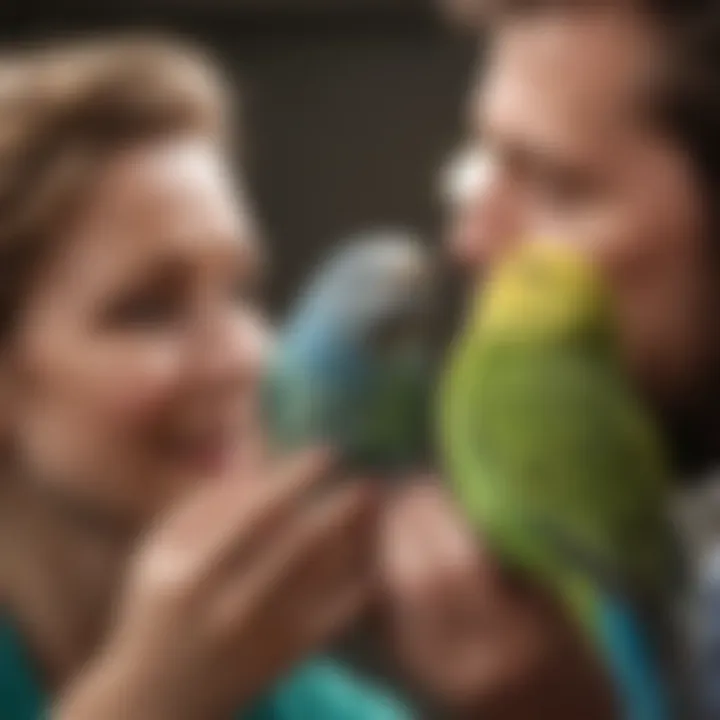
Training your pet bird is a vital component in encouraging it to return to its cage. It directly impacts the relationship you build with your feathered companion. Neither birds nor their owners perform their best in a chaotic environment; hence, establishing clear commands and behaviors is not just a nice-to-have, it's crucial. Employing effective training techniques can enhance your bird's responsiveness, ensure its safety, and reinforce positive behaviors.
Positive Reinforcement Methods
Implementing positive reinforcement methods creates a supportive atmosphere for your pet bird while also promoting desired behaviors. This technique hinges on the idea that birds will repeat actions they associate with pleasurable outcomes. In practical terms, you offer a reward every time your bird returns to its cage.
Consider the following benefits of this approach:
- Increased Trust: It builds trust between you and your pet. When a reward follows an action, the bird feels more connected to you.
- Encouragement of Repetitive Behavior: Your pet learns to associate its return to the cage with a positive result.
- Variety of Rewards: You can use various rewards such as treats, verbal praise, or extra playtime. This creates a customized experience optimal for your bird's likes.
Establishing an effective operation can take time, but consistent practice will yield results. Strive to ensure the training sessions are not too long or demanding. This keeps your bird engaged and eager for further training. If the bird appears stressed or disinterested, give it time to recover and return to it later.
Clicker Training Basics
Clicker training is another method benefits as effective approach for teaching behaviors. It utilizes a small device that makes a clicking noise which can be paired with a reward. The sound of the click becomes an immediate signal to your bird that it performed the desired action correctly.
Here are important points about clicker training:
- Timing of the Click: Click the moment your bird does exactly what you wish it to repeat. This strengthens the association between the desired behavior and the reward.
- Practice with Familiar Commands: Start with simple commands your bird is comfortable with. This serves as a foundational step before introducing more complex tasks.
- Transitioning to Verbal Praise: As your bird becomes familiar with the clicker, introduce verbal commands alongside the clicker. This reinforces communication without relying excessively on the device.
By practicing consistent and clear cues, you foster confidence in the learning process for your pet.
Clicker training requires a degree of patience. Each bird is unique and responds differently to training stimuli. Exploring this method can lead to desirable behaviors, aligning your pet to willingly return to its cage with minimal urgencies applied.
Successfully adopting effective training techniques offers both immediate and long-term benefits. Incorporating positive reinforcement and clicker training strategies can significantly diversify your approach, leading to better engagement with your pet __bird. It creates a behavior-focused interaction that reinforces the bond you share. Each segment in this training journey matters and encourages a more practicing attentiveness to achieve shared trust and dependence.
Using Cues to Encourage Return
Using cues to encourage a pet bird to return to its cage plays a crucial role in managing their behavior and fostering a positive relationship between the bird and owner. Cues are intentional signals that inform your bird about expected actions. The use of both verbal and body language cues opens pathways for clearer communication. By using consistent cues, owners can create a reliable pattern that birds learn to respond to.
Encouraging a bird to return to its cage using cues allows for more orderly behavior and reduces stress during transition periods. When an owner expresses clear expectations through signs and signals, the bird can more easily make choices that align with those behaviors.
Verbal Cues and Commands
Verbal cues are vocal signals used to communicate commands to your bird. By using distinct and consistent phrases, owners can teach birds to associate specific sounds with actions they want them to take. For example, saying
Addressing Behavioral Challenges
Addressing behavioral challenges in pet birds is crucial for both the bird's wellbeing and the owner's peace of mind. Understanding these challenges plays an essential role in ensuring that your bird returns to its cage safely and willingly. Fear and anxiety, as well as natural assertiveness in birds, can heavily influence their behavior. By tackling these issues thoughtfully, owners can create a more secure environment for their feathered friends, enhancing their relationship and reducing stressful situations.
Dealing with Fear and Anxiety
Fear and anxiety in birds can stem from various sources, including loud noises, unfamiliar people, or even a simple change in their environment. When a pet bird feels threatened or anxious, it is less likely to respond positively to commands or cues. Therefore, recognizing signs of fear is pivotal. Look for body language that indicates distress, such as puffed-up feathers, flattened wings, or excessive retreat.
To address these concerns:
- Gradually introduce your bird to new experiences. This approach can help in transitioning them to unfamiliar situations without overwhelming them.
- Use a calm and soothing voice when interacting with your bird. This will convey safety and reassurance.
- Provide hiding spots within the cage or around the house. A safe retreat can reduce feelings of vulnerability and promote a more relaxed demeanor.
It is important to reaffirm positive interactions. Using treats as a form of encouragement can foster confidence, making your bird more likely to return to the cage when called. Creating a safe environment reduces fear, making it easier for them to cooperate during trainings or when it's time to return to their cage.
Understanding Assertiveness in Birds
Assertiveness in birds can manifest through behaviors like squawking loudly or refusing to come back to their cage. Recognizing these assertive signals aids in understanding your bird’s personality and motivations. Every bird has a unique temperament. Their assertiveness should not be mistaken for aggression; it could simply be their instinct to assert independence.
To manage assertive behaviors:
- Establish yourself as a consistent presence in their life, using routines and engagement activities that solidify trust.
- Avoid punitive measures. Harsh responses to assertive behavior can lead to further anxiety and rebellion.
- Encourage collaborative play outside the cage to reinforce the idea that returning to the cage is part of a rewarding experience.
Taking the time to understand assertiveness will help in responding favorably to the demands of your pet bird, leading to better cooperation overall. Ultimately, addressing these behavioral challenges allows for easier strategies when encouraging a bird to return to its cage.
Leveraging Treats and Rewards
Using treats and rewards is a key approach to facilitate a smooth return of your pet bird to its cage. This strategy relies on the principles of positive reinforcement which has proven effective in encouraging desired behaviors in various animal training contexts. When properly executed, leveraging treats helps establish a stronger bond with your bird, turning returns to the cage from a chore into a positive experience. It's crucial to understand not just the mechanics but also the philosophy behind this technique.
Choosing Appropriate Treats
When deciding on treats, consider both the preferences and nutritional needs of your bird. Selecting appropriate treats has several benefits:
- Motivation: Birds are more likely to cooperate when offered something they truly enjoy. Knowing your bird’s favorite snack makes the process more engaging.
- Health guarantees: Opt for low-calorie and nutritious options. Some healthy treats include cut fruits, vegetables, and special bird pellets fortified with vitamins.
Common treat options:
- Sunflower seeds: Though liked, these are to be offered sparingly due to their high-fat content.
- Dried fruits: Like unsweetened dried apricots or cranberries, which most birds find appealing.
- Nuts: Sliced almonds or walnuts can be a good reward choice in moderation.
Mistake to avoid: Never use unhealthy human foods. Chocolate, alcohol, and caffeine are toxic to birds. Always prioritize safe options that provide enjoyment without health risks.
Timing Rewards Effectively
Timing when you offer treats is just as pivotal as the treats themselves. Applying reinforcement at the right moment encapsulates the concept of operant conditioning. Delaying can lead to confusion about which behavior is being rewarded. Here’s how to properly align your timing:

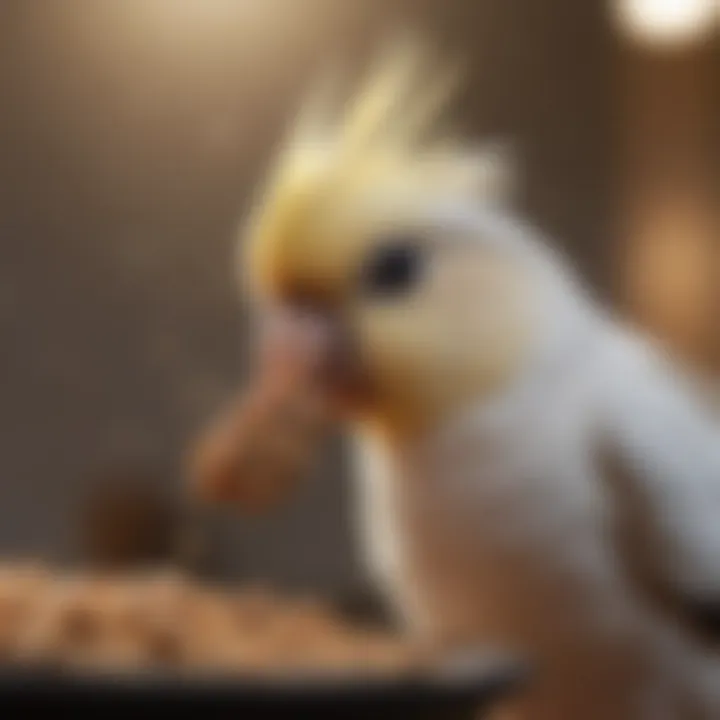
- Immediate reinforcement: Present a treat as soon as your bird takes steps toward the cage. This clarity reinforces the association between the action and the reward.
- Consistency in timings: Establish a routine. For example, if using a specific command or cue, set timeframes – try offering treats consistently at those moments, making learning easier for your bird.
Utilizing a timed approach can instigate not just quicker responses but also a desire for the follow-up behavior over time. Building that deep understanding takes persistence but achieves amplification of compliance over periods.
Remember: Be patient. Birds may require time to learn the connection between the actions and the treat. You are not merely training but also forging a partnership built around trust and mutual respect.
Establishing a Consistent Routine
Establishing a consistent routine is crucial for reinforcing positive behavior in pet birds. Birds thrive when they have clear expectations and know what to expect from their environment. A well-structured routine can make the distinction between a stressed pet and a happy, engaged bird. This consistency gives the bird comfort, making it easier for it to return to its cage voluntarily.
The focus on daily habits helps build strong psychological anchoring in a bird's mind. Familiar schedules promote physical regularity, and a predictably secured environment diminishes anxiety levels. The advantages of a structured approach range from improved well-being to enhanced behavior, making it elementary for any pet bird owner.
Daily Schedule Impacts Behavior
Daily routines can have a substantial effect on avian behavior. Birds, like many pets, are influenced by the rhythms of day and night. Knowing when feeding occurs, when they play, and the times planned for rest significantly matter to them. If feeding times remain consistently at the same hour while varied play sessions happen throughout the day, they understand when to expect activity, which lessens confusion.
To aid behavioral conditioning, homeowners can design a daily schedule that includes:
- Feeding times: Regularity in meals can maintain stable energy levels and influence overall mood.
- Play opportunities: Regular playtimes engage their feelings of safety and establish dependency on positive interactions.
- Cage time: Defining a specific timeframe for going back into the cage allows birds to anticipate that moment without confusion or protest.
A structured routine ejects any uncertainty, leading to a smoother interaction. When birds realize that returning to the cage is integral to their schedule, they develop a crtain expectation around this behavior. The balance of activities throughout the day helps create a sense of comfort, reinforcing the behaviors bird owners want to instill.
Adjusting Routine for Different Species
When considering a routine, it’s vital to acknowledge diferent species respond uniquely. Various types exhibit varying levels of social interactivity and energy requirements. Adjusting your routine based on species needs maximizes their contentment and effectiveness of behavior shaping.
For instance:
- Parakeets may require more social interaction than larger birds, prompting longer periods of play or interaction regularly.
- Cockatiels often have different needs concerning toy stimuli. Rotating toys frequently can promote interest and mental challenges for these individuals.
- African Greys, being naturally curious and highly intelligent, necessitate public engagement, which may gon beyond the cage often to explore different rooms.
Tailoring the routine to consider species strengths and natural behaviors leads toward enriching their daily experience. Recognizing specific instincts and capabilities promotes a deeper understanding and harmony between bird and owner. Thus, structure is not merely a one-size-fits-all approach but rather a foundational element to weather the landscape of species-driven preferences.
It is ultimately the connection between understanding the unique characteristics of each bird species and implementing a behavior management strategy that will yield the best results.
Monitoring Progress and Adjusting Approaches
Monitoring your pet bird’s behavior is essential. By observing its actions, you can determine what approaches work best in encouraging it to return to its cage. Over time, small adjustments can lead to significant improvements. The behavioral shift requires keen observation and a flexible mindset.
Regular assessment gives insights into which techniques resonate with your bird. Some methods might produce quick results, while others take time. Adjusting according to observed progress helps create a more personalized approach to training.
The benefit of careful monitoring extends to building a stronger bond with your bird. They begin to trust you, responding positively to cues and routines you establish.
Keeping a Behavioral Journal
Maintaining a behavioral journal is a crucial strategy. This journal serves as a detailed record of when and how your bird reacts to specific scenarios. Writing down day-to-day observations will let you track changes in behaviors. For instance, you can note how yours responds when called or during tricky training sessions.
A detailed journal structure may include:
- Date and Time: When did the behavior occur?
- Location: Where was the bird at that time?
- Triggers: What happened leading to a certain behavior, do you think?
- Response: How did your bird react? Did it return successfully or not?
- Techniques Used: Which methods did you try on that date?
This information proves invaluable. You can spot trends over the weeks or months. When results aren’t satisfactory, past entry correlations will guide needed changes.
Evaluating Techniques and Making Changes
Once records accumulate, evaluation is the next step. Reviewing your journal will often bring insight. What worked? What did not? Recognizing these patterns allows you to make informed decisions.
Understanding the effectiveness of different techniques is necessary for successful training. Adjust strategies when a method shows signs of being ineffective. That said, be patient. Sometimes, birds take time to respond positively.
Consider the following adjustments:
- Alter the timing of cues or treats. Maybe an earlier or later reward provides better reactions.
- Experiment with environment. A quieter setting may reduce distractions that encourage favorable results.
- Tailor approaches to their preferences, |> some birds enjoy social interactions more, while others prefer solitude.
This ongoing process requires both flexibility and understanding; your methodology must adapt to the unique needs and behaviors of individual birds. Evaluating methods regularly enhances not just training outcomes, but also your overall relationship with your pet bird.
When to Seek Professional Help
As a pet bird owner, understanding your feathered companion's needs is essential. However, there may come a time when strategies implemented for ensuring your pet bird returns to its cage do not yield the desired results. In such cases, seeking professional help is not only beneficial but often necessary. This section delves into key factors to consider when debating if you need to call in an expert.
Recognizing Signs of Distress
Birds are known for hiding their discomfort. Nevertheless, signs of distress can be subtle yet telling. Look for behavioral changes such as:
- Decreased Activity: A bird that is usually lively and social may retreat and become less interactive.
- Feather Plucking: This is often a sign of stress or anxiety.
- Altered Eating Habits: If your bird suddenly stops eating or shows reluctance to try their usual food, that’s a warning sign.
- Aggression: If a typically gentle bird becomes aggressive or defensive, it could indicate underlying stress.
- Changes in Vocalization: An increase or decrease in vocal sounds can show discomfort or health issues.
Ultimately, noticing these changes can guide you towards seeking professional assistance. Ignoring signs of distress may exacerbate the problems your bird experiences.
Finding a Qualified Avian Specialist
When considering professional help, it's crucial to find a vet who specializes in avian care. Unlike general vets, those with avian expertise possess specific skills essential for diagnosing and treating birds. Exploring professional options might include:
- Accreditation and Certification: Look for those who have gone through proper training in avian medicine.
- Experience: Reviews or recommendations highlighting experience with particular species prove valuable as temperament and needs can differ.
- Local Resources: Utilize accessible resources such as the Association of Avian Veterinarians to find qualified specialists in your area. An avian vet can help identify any underlying health issues contributing to behavioral problems.
Remember, approaching your bird's issues with the insights from a qualified professional can increase the overall quality of care you provide.
Seeking help from a veterinarian specialized in avian care is vital. They can address both medical conditions and behavioral challenges, ensuring a healthier, happier life for your pet bird.















